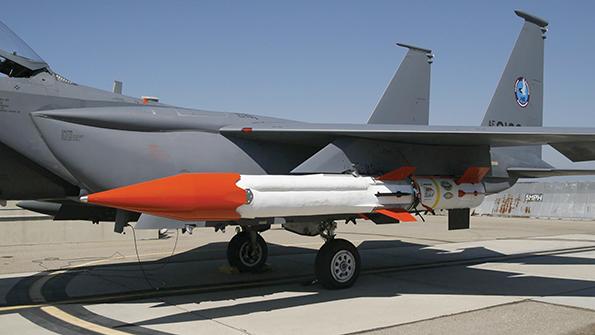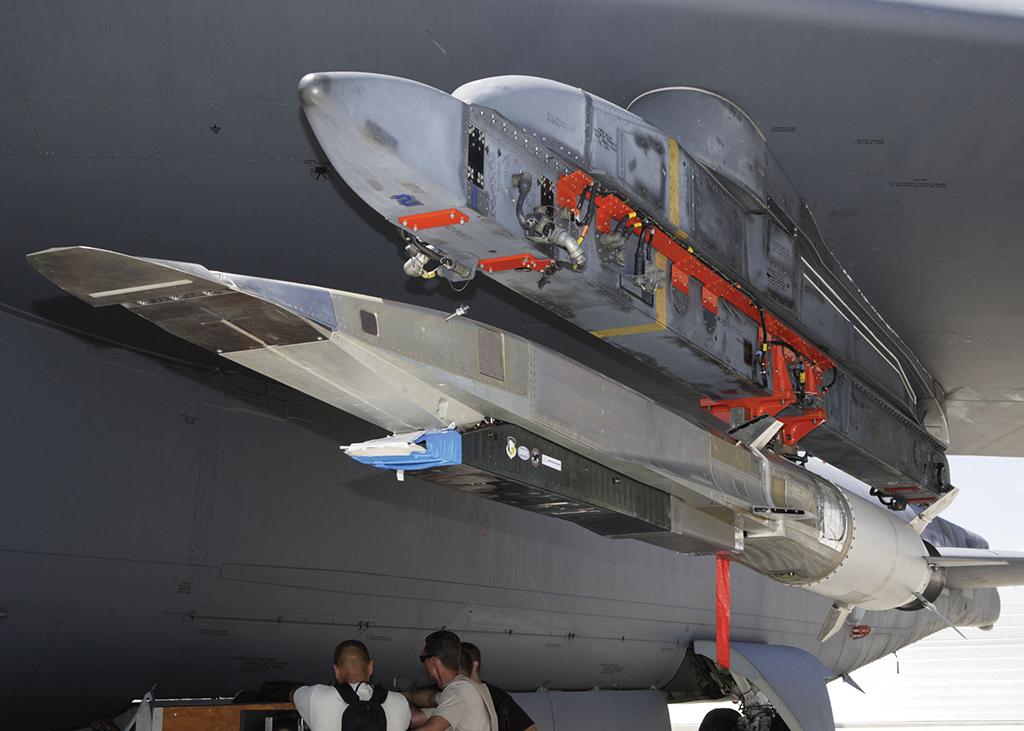
The U.S. Defense Department has revived Boeing’s hopes for a near-term win in the hypersonic weapons market by inserting the company into a competition to build a Mach 6 cruise missile and reviving a decade-old concept based on dual-combustion ramjet technology.
The Joint Hypersonic Transition Office, which was established by Congress this year, has funded a Boeing-led team to complete a preliminary design review (PDR) and ground testing for a dual-combustion ramjet, Gillian Bussey, the office’s director, told reporters on Oct. 27.
In remarks to the Institute for Defense and Government Advancement’s Hypersonic Weapon Summit on Oct. 29, Bussey identified the new program as the “HyFly 2.”
- HyFly 2 contract revives dual-combustion ramjet work
- Hypersonic cruise missile awards planned in fiscal 2022
The name evokes memories of an ambitious joint project between DARPA and the U.S. Navy that culminated in three failed flight tests between 2007 and 2010.
Software, booster and battery issues caused each of the three original HyFly flight tests to end in failure before the critical technology—a dual-ramjet and -scramjet propulsion system designed by a team of Aerojet Rocketdyne and Johns Hopkins University Applied Physics Laboratory—could activate in flight.
The original HyFly test failures proved especially disappointing for the Navy. HyFly’s unique dual-combustion technology would have allowed for a rocket-boosted missile with a relatively low-speed ramjet activation point at around Mach 3.3, which compares to over Mach 4 for the scramjet-powered Boeing X-51A Waverider.
In a dual-combustion system, the ramjet serves as a subsonic gas generator, feeding an accelerated exhaust of superheated gas downstream to a scramjet. The secondary supersonic combustion propels the vehicle up to Mach 6. The Navy originally hoped to apply the HyFly technology to a hypersonic cruise missile optimized for the carrier-based Boeing F/A-18E/F.
The new contract for HyFly 2 comes as the Navy prepares to make a decision in fiscal 2022 on a future hypersonic cruise missile. The HyFly 2 could join two other options in development by teams from Lockheed Martin/Aerojet and Raytheon Technologies/Northrop Grumman. Both teams plan to fly competing demonstrators by the end of this year under the joint DARPA and Air Force-funded Hypersonic Air-breathing Weapon Concept (HAWC) program.

With contract awards for hypersonic cruise missiles planned by the Navy and Air Force in fiscal 2022, Boeing’s upcoming ground tests and PDR offer the services a third technology option. The HyFly 2 concept appears optimized for a carrier-based fighter but could also be applied to the Air Force’s tactical aircraft fleet.
“Our motivation here is to keep other propulsion options on the table,” a U.S. military source says.
“Regardless of whether a service picks up the vehicle concept, we think there is sufficient value in the innovative technologies used in this concept and propulsion design to warrant this level of investment,” a Defense Department spokesman says. “It also provides technological diversity to our hypersonic air-breathing efforts and helps maintain a robust and competitive industrial base.”
After decades of inconsistent support for air-breathing hypersonic propulsion programs, the technology is enjoying a renaissance globally. Experts have speculated that Russia’s hypersonic Zircon anti-ship missile may use a scramjet propulsion system, but the Kremlin has never elaborated on the specific technologies used. China has openly performed flight tests as recently as 2018 on an experimental scramjet-powered vehicle called the Starry Sky-2. In September, India joined the air-breathing propulsion club, completing a Mach 6 test flight of the Hypersonic Technology Demonstration Vehicle testbed, according to the Defense Research and Development Organization.
The U.S. defense industry, meanwhile, is gearing up for a new era of mass production of scramjet-powered, hypersonic cruise missiles. During a third-quarter earnings call in October, Northrop CEO Kathy Warden said the company is investing now to support low-rate initial production of hypersonic cruise missiles within 4-5 years. Northrop’s Innovation Systems division, formerly Orbital ATK, supplies the scramjet engine for Raytheon’s HAWC design.
Although Boeing’s hypersonic profile has diminished considerably since the final flight success of the X-51A in 2013, the company’s reentry into the picture with the HyFly 2 project is not a surprise.
“We continue to invest in this area and are focused on developing and maturing key technologies for both commercial and defense applications,” a Boeing spokesman says. “As mentioned during the Hypersonic Weapons Summit, Boeing is currently engaged with propulsion risk reduction and will be performing preliminary design review.”
Despite the flurry of hypersonic missile-related awards in recent years to Lockheed and Raytheon, Boeing has quietly continued high-speed technology development in support of several high-Mach research, weapons and aircraft projects.
Like the X-51A, the company’s ongoing development work builds on a foundation of hypersonic experience ranging back to the rocket-powered experimental X-15 aircraft of the 1950s and 1960s and the Advanced Maneuvering Reentry Vehicle (AMaRV) program, which ran until 1988. Decades of hypersonic reentry experience were also amassed during the space shuttle era, and Boeing continues to build on that with operations of the Boeing-built X-37B for the U.S. Air Force.
The company’s pioneering foray into air-breathing scramjets began with the X-43 program with NASA, which ended in 2004 after setting two consecutive airspeed records at Mach 6.8 and 9.6.
Beyond the follow-on X-51A, Boeing also continued the HIFiRE hypersonic research program that in 2017 successfully tested flight control of the company’s waverider glider with the Air Force Research Laboratory and the Defense Science Technology Group in Australia.
Boeing’s long-running air-breathing engines partnership with Aerojet Rocketdyne also extended to include work on the rocket-powered XS-1 Phantom Express reusable spaceplane demonstration vehicle with DARPA, a project from which Boeing withdrew this year.
However, Boeing has also partnered with the former Orbital ATK on recent air-breathing hypersonic projects with DARPA and the Air Force. Boeing and Orbital ATK teamed up for the DARPA-led Advanced Full Range Engine (AFRE) initiative, which is testing elements of a turbine-based combined-cycle (TBCC) propulsion system designed for future runway-based reusable hypersonic vehicles operating at up to Mach 5.
AFRE builds on previous Mode Transition and Falcon Combined-Cycle Engine Technology (FaCET) efforts—the latter completed in 2009—and combines an off-the-shelf turbine and dual-mode ramjet/scramjet (DMRJ). The AFRE engine uses mass-injection precompressor cooling to boost the maximum speed of the turbine. The water injection system, together with the common turbine/DMRJ inlet, combustor and nozzle are due to be integrated later this year into the complete TBCC assembly with freejet testing of the engine expected in 2021.
In the past two years, Boeing has also unveiled ambitious plans for long-term development of larger-scale military and commercial hypersonic vehicles. Although inevitably affected by slowdowns related to the COVID-19 pandemic and the company’s commercial financial woes, the eventual focus is a subscale flying demonstrator that could provide the foundation for several follow-on air-breathing vehicles.
Announced in 2018, the reusable Mach 5-plus demonstrator vehicle design is initially aimed at a future high-speed strike and reconnaissance aircraft. The sharply swept delta-wing vehicle concept builds on the X-43 and X-51A hypersonic demonstrator programs as well as Boeing heritage company high-speed projects including the Mach 3 XB-70 experimental bomber. Like the outwardly similar SR-72 concept revealed in 2013 by Lockheed Martin, the Boeing design is aimed at a successor later this decade to the long-retired SR-71 Blackbird reconnaissance aircraft.
The commercial hypersonic concept is targeted at cruise speeds of Mach 4 or 5 and an operational altitude of up to 95,000 ft. to enable same-day return flights, even across the Pacific. More recently, in August of this year, Boeing also revealed interest in supporting the development of a Mach 3 supersonic transport project with Virgin Galactic.
In related developments: Boeing has invested in UK-based Reaction Engines, which is developing air-breathing propulsion for high-speed flight. Alongside Rolls-Royce and BAE Systems, Boeing formed part of a $37.3 million funding round for Reaction Engines in April 2018, and Boeing’s stake in Aerion’s Mach 1.4 AS2 supersonic business jet project was announced in February 2019.


